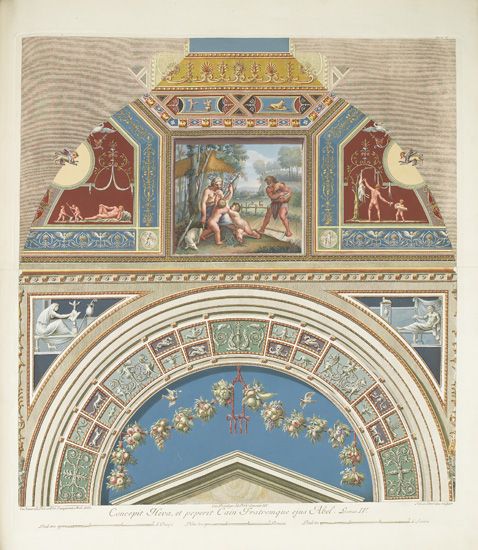RAPHAEL Sanzio d'Urbino (1483-1520)]. Delle Loggie di Rafaele nel Vaticano . Rome: 1772-76. Parts I and III (of 3), oblong 2° (477 x 614mm). Part I: general view of the gallery with title and portrait of Raphael, panoramic view on 3 sheets, 2 double-sheet plates of doors lettered A and B, and 14 double-sheet plates number I-XIV by Giovanni Ottaviani after C. Savorelli and P. Camporesi (lacking letterpress text leaf); part III: 12 double-page plates by Giovanni Volpato after Ludovico Teseo numbered 1-12 (lacks title). (Marginal repaired tear in plate III, a few light spots, some light surface soiling, plates 8-10 just shaved at top left edge, a few creases.) Late 18th-century calf-backed boards (extremities rubbed, slightly scuffed). The Loggie in the Vatican Palace as begun by Bramante and finished by Raphael consists of 13 bays. Raphael was commissioned by Leo X (1513-1521) upon Bramante's death in 1514 and the work was completed in 1519. The finely engraved plates show the columns in the loggias as designed and painted by Raphael. The plates for part I were engraved by Giovanni Ottaviani (1735 - 1808) after drawings by Gaetano Savorelli (d. 1791) and Pietro Camporese (1763 - 1822), the plates for the third part are by Giovanni Volpato (1733 - 1803) after drawings by Ludovico Teseo (1731 - 1782). Giovanni Volpato is well-known for his engravings after Raphael, in particular the present work and the frescos in the Stanza della Segnatura (see Giorgio Marini Giovanni Volpato 1735-1803 . Basso al Grappa: 1988, nos. 173-198, and also nos. 213-219). This work, in as much as it portrays decoration which has been considered marginal to Bramante's and Raphael's overall plans, is thought to have been instrumental in encouraging a revival of interest peripheral art, otherwise known as 'grotesque' art; this view belies the interest of these plates both artistically and historiographically, and these engravings after Raphael are important for understanding the contemporary perception and 'use' of the work of one of the greatest of Renaissance artists. There appears to be a considerable degree of confusion on the number and content of the constituent parts; the intentions of the collaborating artists are not known, and copies of this work have been catalogued as requiring and having parts, plates, and states which do not necessarily correspond with the literature. In den Jahren 1772-76 machte er [Camporese] mit dem Maler Savorelli die Vorzeichnungen zu den beiden ersten Bänden des Stichwerkes "Le Loggie di Raffaello nel Vaticano" (Roma 1772, res. 1776). (Thieme-Becker V p.478). Although the relationship between the number of parts and the history of their production is not fully known or understood, 3 parts are held to be the sum of the work.
RAPHAEL Sanzio d'Urbino (1483-1520)]. Delle Loggie di Rafaele nel Vaticano . Rome: 1772-76. Parts I and III (of 3), oblong 2° (477 x 614mm). Part I: general view of the gallery with title and portrait of Raphael, panoramic view on 3 sheets, 2 double-sheet plates of doors lettered A and B, and 14 double-sheet plates number I-XIV by Giovanni Ottaviani after C. Savorelli and P. Camporesi (lacking letterpress text leaf); part III: 12 double-page plates by Giovanni Volpato after Ludovico Teseo numbered 1-12 (lacks title). (Marginal repaired tear in plate III, a few light spots, some light surface soiling, plates 8-10 just shaved at top left edge, a few creases.) Late 18th-century calf-backed boards (extremities rubbed, slightly scuffed). The Loggie in the Vatican Palace as begun by Bramante and finished by Raphael consists of 13 bays. Raphael was commissioned by Leo X (1513-1521) upon Bramante's death in 1514 and the work was completed in 1519. The finely engraved plates show the columns in the loggias as designed and painted by Raphael. The plates for part I were engraved by Giovanni Ottaviani (1735 - 1808) after drawings by Gaetano Savorelli (d. 1791) and Pietro Camporese (1763 - 1822), the plates for the third part are by Giovanni Volpato (1733 - 1803) after drawings by Ludovico Teseo (1731 - 1782). Giovanni Volpato is well-known for his engravings after Raphael, in particular the present work and the frescos in the Stanza della Segnatura (see Giorgio Marini Giovanni Volpato 1735-1803 . Basso al Grappa: 1988, nos. 173-198, and also nos. 213-219). This work, in as much as it portrays decoration which has been considered marginal to Bramante's and Raphael's overall plans, is thought to have been instrumental in encouraging a revival of interest peripheral art, otherwise known as 'grotesque' art; this view belies the interest of these plates both artistically and historiographically, and these engravings after Raphael are important for understanding the contemporary perception and 'use' of the work of one of the greatest of Renaissance artists. There appears to be a considerable degree of confusion on the number and content of the constituent parts; the intentions of the collaborating artists are not known, and copies of this work have been catalogued as requiring and having parts, plates, and states which do not necessarily correspond with the literature. In den Jahren 1772-76 machte er [Camporese] mit dem Maler Savorelli die Vorzeichnungen zu den beiden ersten Bänden des Stichwerkes "Le Loggie di Raffaello nel Vaticano" (Roma 1772, res. 1776). (Thieme-Becker V p.478). Although the relationship between the number of parts and the history of their production is not fully known or understood, 3 parts are held to be the sum of the work.









.jpg)
Testen Sie LotSearch und seine Premium-Features 7 Tage - ohne Kosten!
Lassen Sie sich automatisch über neue Objekte in kommenden Auktionen benachrichtigen.
Suchauftrag anlegen